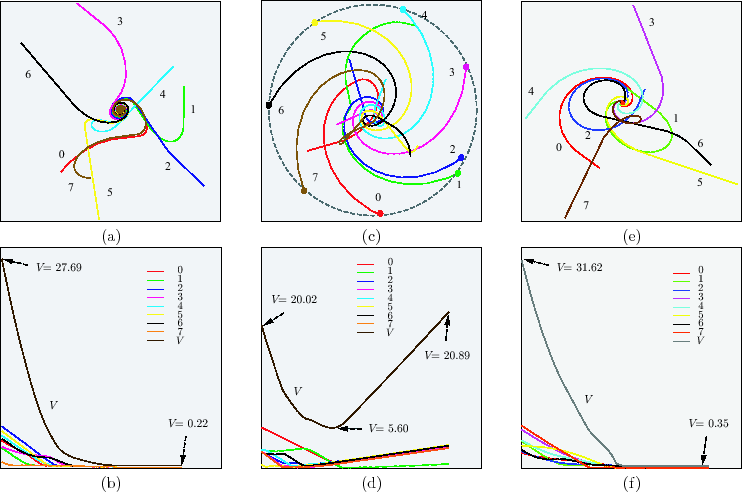A Java implementation was written to verify the theoretical developments, which focuses on the two key scenarios of rendezvous: assignment graph with a single cycle and assignment graph with a cycle plus branches. The program2 was developed adhering to the Java 5 language standard under the Eclipse environment.
Discretization is necessary to implement the continuously evolving system. Sensing needs to be discretized because the Dubins car model allows jumps in angular velocity; therefore, there could be a large number of control switches within a short time interval. In our implementation, we divide the windshield into a left sector and a right sector. The triggering event is simulated by remembering the latest observation of the target agent ![]() 's relative position in pursuing agent
's relative position in pursuing agent ![]() 's windshield at time step
's windshield at time step ![]() ,
,
![$\displaystyle y_i[k] = \left\{ \begin{array}{ll} -1 & \textrm{agent $j$ is in ...
... of view} 1 & \textrm{agent $j$ is in the right sector}, \end{array} \right.$](img230.gif) |
(42) |
![$\displaystyle u_i[k] = \left\{ \begin{array}{ll} \omega & \textrm{$y_i[k] = 0, ...
... = 0, y_i[k - 1] = 1 $} u_i[k-1] & \textrm{otherwise}, \end{array} \right.$](img231.gif) |
(43) |
 |
To verify the cyclic pursuit theorems for the Dubins car model, each agent is assigned a unique integer identifier. For the single cycle case, we initialize the system by positioning the agents randomly and assigning each agent to the one with a preceding identifier; the first agent is assigned to the last one. The behavior of the cyclic pursuit is then observed by watching the agents' trajectories and a simultaneously drawn plot of the Lyapunov function, under different parameter settings. Since we want to observe the behavior of the cyclic pursuit with all agents, the merging radius ![]() is set to near zero to inhibit merging. For every attempted set of
is set to near zero to inhibit merging. For every attempted set of ![]() agents, the simulation indicates that
agents, the simulation indicates that
![]() is a tight rendezvous bound. As predicted, randomly positioned agents rendezvous when
is a tight rendezvous bound. As predicted, randomly positioned agents rendezvous when
![]() , but they will eventually diverge if
, but they will eventually diverge if ![]() is only
is only ![]() above
above ![]() . In the latter case, the agents get closer quickly in the beginning as random arrangements appear to induce more negative
. In the latter case, the agents get closer quickly in the beginning as random arrangements appear to induce more negative ![]() . Interestingly, the agents then tend to arrange themselves on a circle and eventually form a regular polygon, making
. Interestingly, the agents then tend to arrange themselves on a circle and eventually form a regular polygon, making ![]() positive. We speculate that the continuous system has the same behavior, which is shown in [28,31] with different motion primitive and/or control law. Fig. 6 a) - d) shows both a converging and a diverging case with
positive. We speculate that the continuous system has the same behavior, which is shown in [28,31] with different motion primitive and/or control law. Fig. 6 a) - d) shows both a converging and a diverging case with ![]() . In the rendezvous case,
. In the rendezvous case, ![]() does not go to zero because
does not go to zero because ![]() is set to be very small. The case with cycle plus branches is implemented similarly: we make a random cycle (with less than
is set to be very small. The case with cycle plus branches is implemented similarly: we make a random cycle (with less than ![]() agents) and then attach the rest of the agents to the cycle in a random way. Its simulation behavior (a converging example is shown in Fig. 6 e) - f)) is very similar to the single cycle case.
agents) and then attach the rest of the agents to the cycle in a random way. Its simulation behavior (a converging example is shown in Fig. 6 e) - f)) is very similar to the single cycle case.